U.S. Home Starts -45% since January; Canada, -24%
The story of the recent deterioration in U.S. and Canadian housing starts can best be told through a series of graphs. Both nations began this year with relatively high levels of residential groundbreakings.

In January 2020, the U.S. recorded 1.617 million units seasonally adjusted at an annual rate (SAAR) and Canada, 219,000 units (also SAAR).
The decline in new home starts in the U.S. during the latest two months, however, has been brutal. First, they shrank to 1.3 million units in March, then to 0.9 million in April.
New home starts in America in April were cut by nearly half (-45%) versus January.
Canada’s contraction, January to April, has been one-quarter. The 166,000-unit figure for Canada in the latest month, though, comes with an asterisk. Construction in Quebec was shut down in April, yielding housing start counts of zero throughout the province. (Never before has there been a non-existent official number for housing starts in Montreal in any month.)
Quebec’s construction scene is open again as of May 1st.
Pennsylvania also placed a ban on construction in April, but the state’s relationship to ‘total U.S.’ statistics is smaller than the Quebec-to-Canada one. (Quebec accounts for 22.5% of Canada’s population.)
Just the same, the stark Northeast Region housing start statistics appearing in this article have been pushed downwards by the brief halt in Pennsylvania site work.
Graph 1: U.S. Monthly Housing Starts
Seasonally Adjusted at Annual Rates (SAAR)
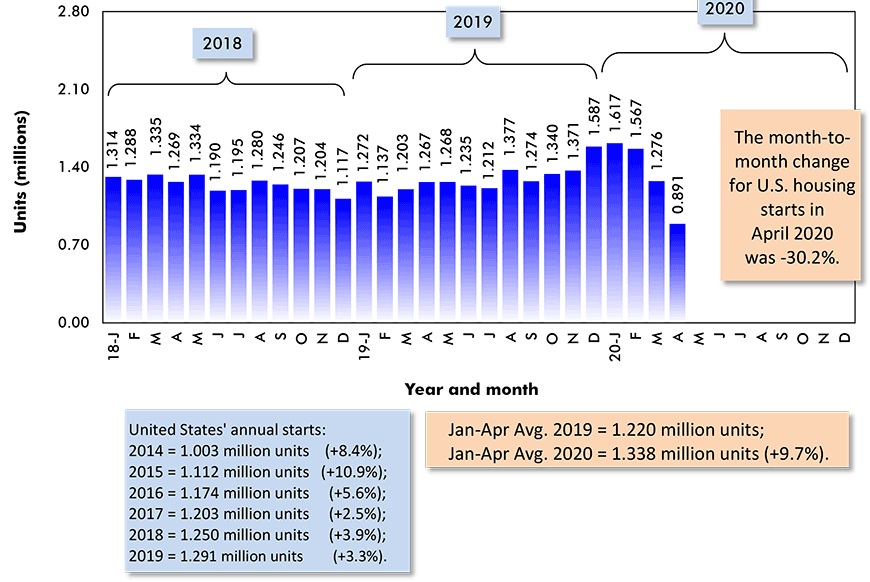
Data source: U.S. Census Bureau (Department of Commerce).
Chart: ConstructConnect.
Graph 2: Canada Monthly Housing Starts
Seasonally Adjusted at Annual Rates (SAAR)
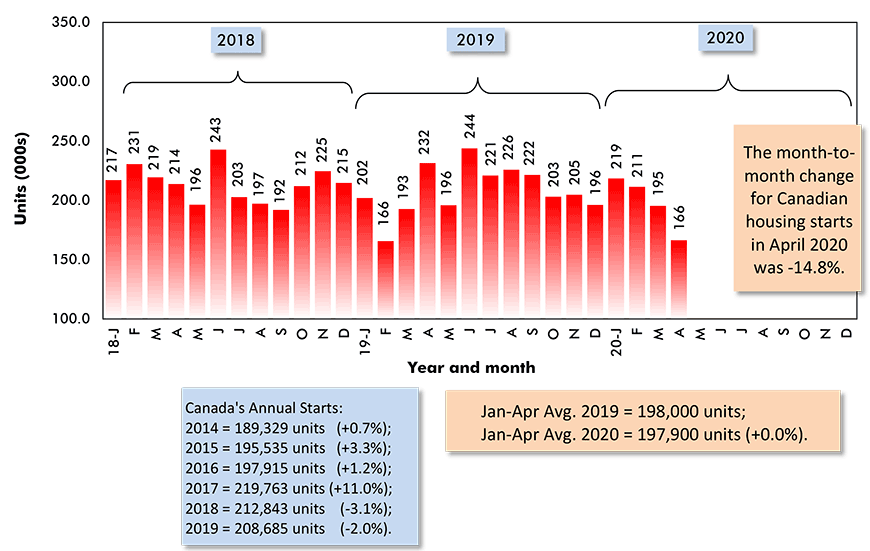
Data source: Canada Mortgage and Housing Corporation (CMHC).
Chart: ConstructConnect.
Graph 3: U.S. and Canada Monthly Housing Starts
Seasonally Adjusted at Annual Rates (SAAR)

The last data points are for April, 2020.
ARROWS: U.S. numbers to be read from left axis; Canadian from right axis.
Data sources: U.S. Census Bureau & Canada Mortgage and Housing Corp (CMHC).
Chart: ConstructConnect.
Graph 4: U.S. Total Monthly Housing Starts
Seasonally Adjusted at Annual Rates (SAAR)
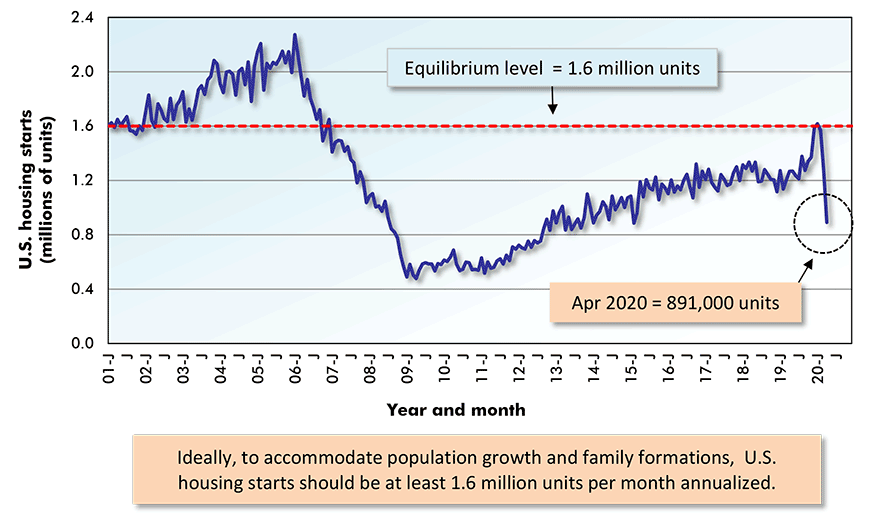
The last data point is for April, 2020.
Data source: U.S. Census Bureau (Department of Commerce).
Chart: ConstructConnect.
Multi-family Living falls out of Favor
As mentioned previously, total U.S. housing starts in April were -30% month to month and -45% since January, at the beginning of this year. The ‘single-family’ versus ‘multi-family’ composition of total starts is taking an interesting turn.
In a time of ‘social distancing’, the demand for new high-density multi-family units has fallen out of favor. U.S. single-family housing starts in April were -25.4% month to month. Multi-family starts, though, were more negative, -40.5%.
More disturbing yet, consider what’s happened relative to January. Compared with January’s number-of-unit levels, singles in the latest month were lower by a third (-34%), but multis were down by nearly two-thirds (-62%).
Year to date, singles (in units) have accounted for two-thirds of total starts and multis, the remaining one-third. The respective shares will continue to be weighted more towards singles as the year continues to unfold.
As for total residential building permits, on a SAAR basis, they were -20.8% month to month in April. Compared with January, they were -30.1%.
Usually permits lead starts, but at this time, it may simply be the case that taking out a permit is an easier exercise than physically putting a shovel in the ground.
Graph 5: U.S. Single-Family and Multi-Family Housing Starts
Seasonally Adjusted at Annual Rates (SAAR)
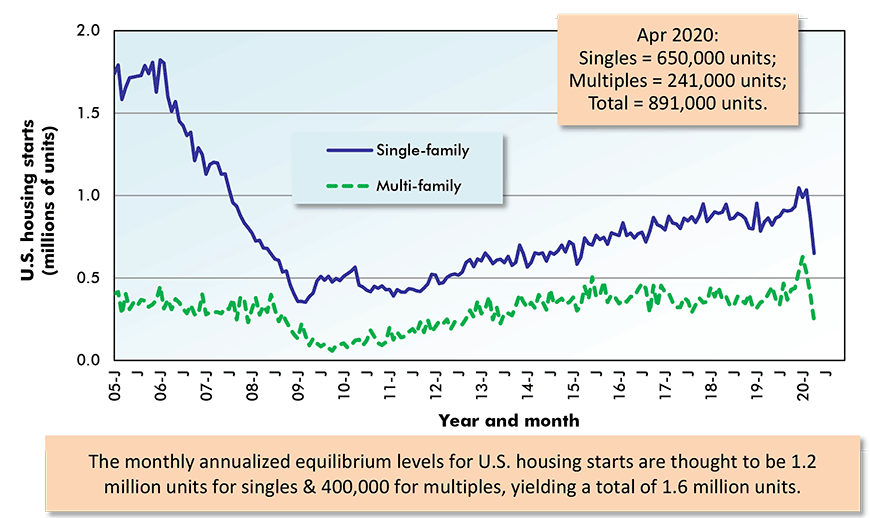
The last data points are for April, 2020.
Data source: U.S. Census Bureau (Department of Commerce).
Chart: ConstructConnect.
Graph 6: U.S. Monthly Residential Building Permits
Seasonally Adjusted at Annual Rates (SAAR)

The last data points are for April, 2020.
Data source: U.S. Census Bureau (Department of Commerce).
Chart: ConstructConnect.
U.S. Northeast Housing Starts -80% since January
Regionally in America, the Northeast and West staged the speediest retreats in housing starts in April, -43.6% and -43.4% respectively. The South’s decline was -26.0%. The Midwest, by comparison, was barely bothered, -14.9%.
Clearer pictures of the plummets in the Northeast and West are more apparent, however, when April is held up against January. April’s drop versus three months earlier was -60% in the West and a throat-tightening -80% in the Northeast.
Through April, regional shares of year-to-date total American housing starts have been: Northeast, 9%; Midwest, 12%; South, 54%; and West, 25%.
Graph 7: U.S. Regional Housing Starts
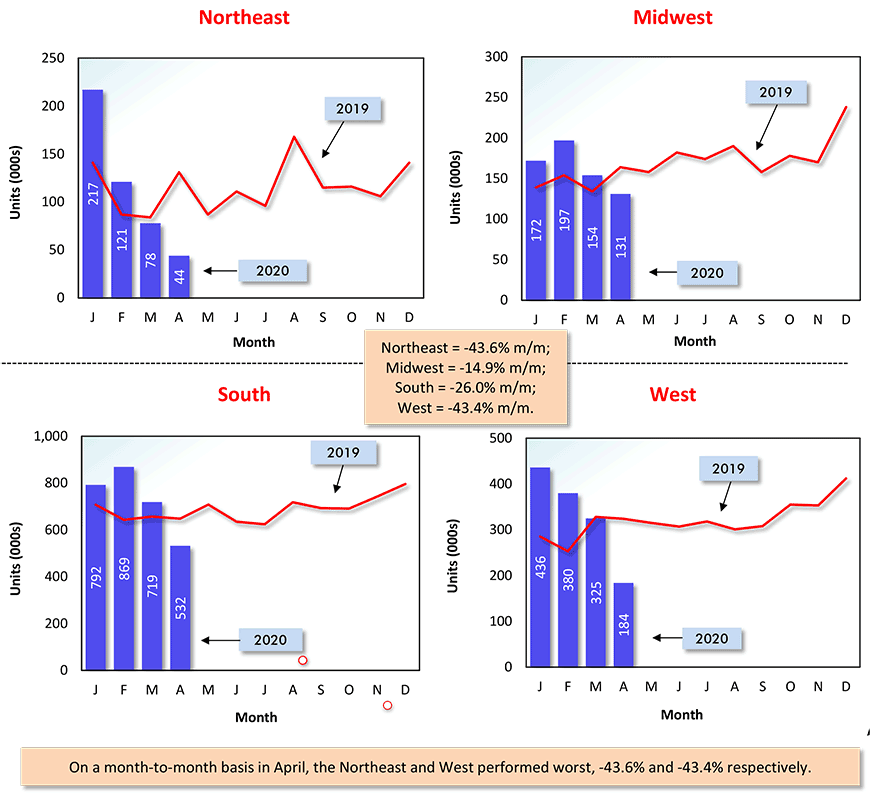
Figures are seasonally adjusted at annual rates (SAAR).
Data source: U.S. Census Bureau.
Chart: ConstructConnect.
Graph 8: U.S. Housing Starts
April 2020 versus March 2020 (M/M)
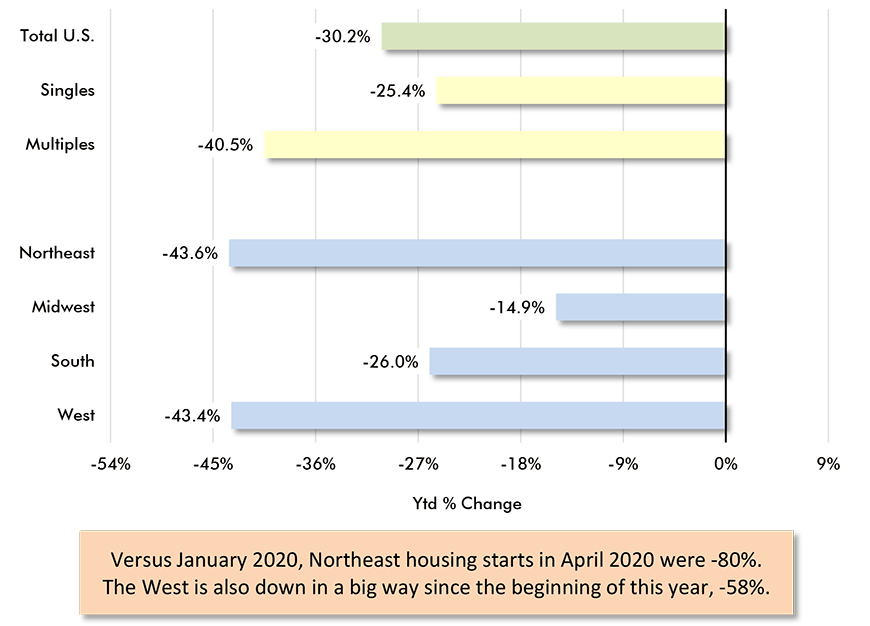
Based on monthly figures that have been seasonally adjusted and annualized (SAAR).
Data source: U.S. Census Bureau.
Chart: ConstructConnect.
Edmonton Housing Starts +33%; Vancouver, -34%
In Canadian provinces and cities through April, the balance between plus percentage changes and minuses for year-to-date housing starts was still leaning slightly more towards the ‘up’ side.
Prince Edward Island and New Brunswick have seen a doubling in their new home groundbreakings year to date. At the opposite end of the spectrum, B.C. has witnessed a one-quarter decline. The province of Quebec is also severely down (-27%), but the government-decreed site-work shutdown in April has muddied the statistical waters.
Among Canada’s six cities with populations in excess of a million people, Edmonton has done well in housing starts year to date, +33%. The nation’s capital, Ottawa, is also firmly ‘in the black’, +22%.
Vancouver’s experience, though, has been far less sanguine, -34%.
Graph 9: Percent Change in Year-To-Date Housing Starts –
Ranking Of Canada’s Provinces
(Jan-Apr 2020 vs Jan-Apr 2019)

Data source: Canada Mortgage & Housing Corporation (CMHC) based on actuals rather than seasonally adjusted data.
Chart: ConstructConnect.
Graph 10: Percent Change in Year-To-Date Housing Starts –
Ranking Of Canada’s Major Cities
(Jan-Apr 2020 vs Jan-Apr 2019)

Canada’s Census Metropolitan Areas (CMAs) have core populations of 50,000 plus.
Canada’s 6 CMAs with populations in excess of 1 million are in capital letters.
Data source: Canada Mortgage & Housing Corporation (CMHC) based on actuals rather than seasonally adjusted data.
Chart: ConstructConnect.
Alex Carrick is Chief Economist for ConstructConnect. He has delivered presentations throughout North America on the U.S., Canadian and world construction outlooks. Mr. Carrick has been with the company since 1985. Links to his numerous articles are featured on Twitter @ConstructConnx, which has 50,000 followers.











Recent Comments